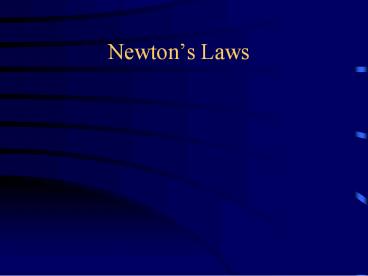Newton - PowerPoint PPT Presentation
Title:
Newton
Description:
Title: Integrative Studies 410 Our Place in the Universe Author: DRobertson Last modified by: Windows User Created Date: 3/27/2002 9:47:52 PM Document presentation format – PowerPoint PPT presentation
Number of Views:91
Avg rating:3.0/5.0
Title: Newton
1
Newtons Laws
2
Achieving Scientific Literacy(Arons Article)
- Two types of knowledge
- Declarative (Learned Facts, book knowledge)
- Operative (actually knowing how to solve
problems) - Trouble with GenEd courses
- Too much in too little time
- Getting a feeling for the subject doesnt work
- Need to understand the underpinnings first (area,
volume, scaling, energy, atoms,)
3
How far away is the Moon?
- The Greeks used a special configuration of Earth,
Moon and Sun (link) in a lunar eclipse - Can measure EF in units of Moons diameter, then
use geometry and same angular size of Earth and
Moon to determine Earth-Moon distance - See here
- for method
4
Earths Shadow on the Moon (UT)
5
Earths Shadow on the Moon (NASA)
6
Geometrical Argument
- Triangles AFE and EDC are congruent
- We know ratio FE/ED f
- Therefore AEf EC, and AC (1f)EC
- AC108 REarth
- EC distance
- to Moon
7
That means we can size it up!
- We can then take distance (384,000 km) and
angular size (1/2 degree) to get the Moons size - D 0.5/3602p384,000km 3,350 km
8
How far away is the Sun?
- This is much harder to measure!
- The Greeks came up with a lower limit, showing
that the Sun is much further away than the Moon - Consequence it is much bigger than the Moon
- We know from eclipses if the Sun is X times
bigger, it must be X times farther away
9
Simple, ingenious idea hard measurement
10
Timeline
11
Isaac Newton The Theorist
- Key question
- Why are things happening?
- Invented calculus and physics while on vacation
from college - His three Laws of Motion, together with the Law
of Universal Gravitation, explain all of Keplers
Laws (and more!)
Isaac Newton (16421727)
12
Isaac Newton (16421727)
- Major Works
- Principia (1687)
- Full title Philosophiae naturalis principia
mathematica - Opticks sic!(1704)
- Later in life he was Master of the Mint, dabbled
in alchemy, and spent a great deal of effort
trying to make his enemies miserable
13
Newtons first Law
- In the absence of a net external force, a body
either is at rest or moves with constant
velocity. - Contrary to Aristotle, motion at constant
velocity (may be zero) is thus the natural state
of objects, not being at rest. Change of velocity
needs to be explained why a body is moving
steadily does not.
14
Mass Weight
- Mass is the property of an object
- Weight is a force, e.g. the force an object of
certain mass may exert on a scale
15
Newtons second Law
- The net external force on a body is equal to the
mass of that body times its acceleration
F ma. - Or the mass of that body times its acceleration
is equal to the net force exerted on it - ma F
- Or aF/m
- Or mF/a
16
Newtons 3rd law
- For every action, there is an equal and opposite
reaction - Does not sound like much, but thats where all
forces come from!
17
Newtons Laws of Motion (Axioms)
- Every body continues in a state of rest or in a
state of uniform motion in a straight line unless
it is compelled to change that state by forces
acting on it (law of inertia) - The change of motion is proportional to the
motive force impressed (i.e. if the mass is
constant, F ma) - For every action, there is an equal and opposite
reaction (Thats where forces come from!)
18
Newtons Laws
Always the same constant pull
- a) No force particle at rest
- b) Force particle starts moving
- c) Two forces particle changes movement
- Gravity pulls baseball back to earth
- by continuously changing its velocity
- (and thereby its position)
-
?
19
Law of Universal Gravitation
- Force G Mearth Mman / R2
20
Orbital Motion
21
Cannon Thought Experiment
- http//www.phys.virginia.edu/classes/109N/more_stu
ff/Applets/newt/newtmtn.html
22
From Newton to Einstein
- If we use Newton II and the law of universal
gravity, we can calculate how a celestial object
moves, i.e. figure out its acceleration, which
leads to its velocity, which leads to its
position as a function of time - ma F GMm/r2
- so its acceleration a GM/r2 is independent of
its mass! - This prompted Einstein to formulate his
gravitational theory as pure geometry.
23
Applications
- From the distance r between two bodies and the
gravitational acceleration a of one of the
bodies, we can compute the mass M of the other - F ma G Mm/r2 (m cancels out)
- From the weight of objects (i.e., the force of
gravity) near the surface of the Earth, and known
radius of Earth RE 6.4?103 km, we find ME
6?1024 kg - Your weight on another planet is F m ? GM/r2
- E.g., on the Moon your weight would be 1/6 of
what it is on Earth
24
Applications (contd)
- The mass of the Sun can be deduced from the
orbital velocity of the planets MS
rOrbitvOrbit2/G 2?1030 kg - actually, Sun and planets orbit their common
center of mass - Orbital mechanics. A body in an elliptical orbit
cannot escape the mass it's orbiting unless
something increases its velocity to a certain
value called the escape velocity - Escape velocity from Earth's surface is about
25,000 mph (7 mi/sec)































